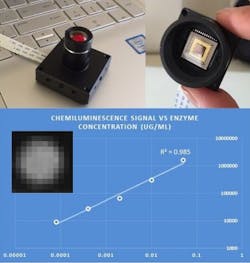Portable chemiluminescence biosensor detects analyte down to a few nanograms
Anitoa Systems (Menlo Park, CA) has applied its low-cost, portable CMOS chemiluminescence biosensor with a chemiluminescence immunoassay (CLIA). The combination approach is able to detect as low as a few nanograms-per-millliter of analyte (such as protein macromolecules) in a sample for use in clinical diagnostics, as well as in food safety and environmental monitoring.
Related: Infectious disease control with portable CMOS-based diagnostics
A key component of the company's portable chemiluminescence reader is its proprietary ULS24 CMOS biosensor chip. Endowed with extreme low-light sensitivity, it forms a single-chip chemiluminescence imaging device. The device also eliminates the need for a multi-sites scanning mechanism commonly used by most chemiluminescence readers when performing real-time imaging of multiple immunoassay reaction sites. At a 5 × 5 mm footprint and 30 mW power comsumption, the biosensor is has particular utility in point-of-care diagnostics.
Released commercially in September 2014, the biosensor has the needed sensitivity to substitute bulky, expensive photomultiplier tubes (PMTs) and cooled CCDs in a wide range of medical and scientific instruments. Its ultra-low light sensitivity (3e-6 lux) is crucial for achieving good signal-to-noise ratio (SNR) in imaging molecular interactions based on fluorescence or chemiluminescence signaling principles.
Immunoassays are important for detecting macromolecules in a sample (such as blood) using an antibody as probes. It has been used widely in diagnostics (infectious diseases, heart diseases), food safety, pharmaceutical analysis, and environmental monitoring. Based on the chemiluminescence signaling principle, chemiluminescence-based immunoassays provide orders-of-magnitude higher sensitivity and dynamic range than traditional color absorbance-based immunoassays (e.g., ELISA).
For more information, please visit www.anitoa.com.
